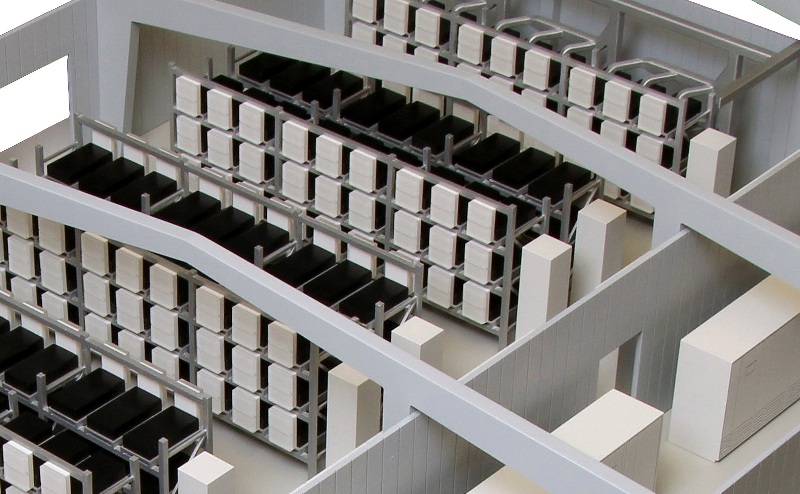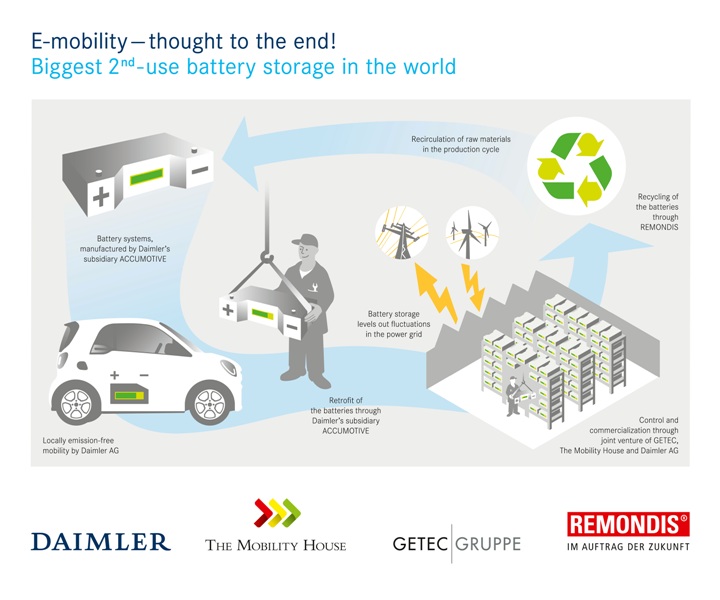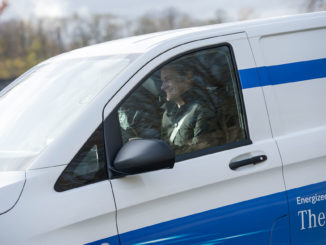Il più grande impianto stazionario mondiale che impiega batterie usate è in fase di avviamento
• Deposito di batterie da 13 MWh situato a Lünen
• Batterie per veicoli elettrici utilizzate anche per assorbire le fluttuazioni nella rete elettrica tedesca
• La cooperazione tra Daimler, The Mobility House, GETEC e REMONDIS completa il circuito del valore aggiunto della batteria
Fonte: Daimler AG
Lünen e Stoccarda. Germania. 13 Settembre 2016. Il più grande impianto di stoccaggio batterie e produzione di energia a partire da accumulatori usati è in fase di avviamento. Il progetto da 13 MWh è ormai in fase di completamento, dopo un tempo di costruzione di poco meno di un anno: un totale di 1000 sistemi di batterie provenienti dalle auto smart fortwo electric drive di seconda generazione vengono raggruppati in un deposito batterie a Lünen, in Westfalia. Le prime unità di alimentazione sono già nella griglia. Lo stoccaggio delle batterie da 13 MWh metterà la sua piena capacità a disposizione del mercato energetico tedesco prima della fine di quest’anno.
L’energia in output sarà disponibile per il vincitore delle aste settimanali tra gli operatori di rete per la gamma di potenza di controllo primario, con accumulo di energia completamente automatico e feed-in.
 Mentre l’energia è sempre più prodotta dalle fluttuanti fonti di energie rinnovabili come impianti eolici o centrali solari, i depositi ad alta capacità della batteria sono la chiave per stabilizzare le reti elettriche.
Mentre l’energia è sempre più prodotta dalle fluttuanti fonti di energie rinnovabili come impianti eolici o centrali solari, i depositi ad alta capacità della batteria sono la chiave per stabilizzare le reti elettriche.
Secondo i dati del Ministero tedesco dell’Economia e l’energia (BMWi), dal 40 al 45 per cento dell’energia consumata in Germania deve essere generata da fonti rinnovabili entro il 2025, aumentando dal 55 al 60 per cento entro il 2035.
La gestione efficiente delle risorse energetiche e materiali si applica anche a tutti i componenti utilizzati nella mobilità elettrica.
La joint venture tra i partner Daimler AG, The Mobility House AG e GETEC ha una risposta orientata al futuro per quanto riguarda la questione chiave di riutilizzare i sistemi di batterie delle auto elettriche con questo immagazzinaggio della batteria usata. Poiché il ciclo di vita di una batteria del veicolo elettrico non finisce dopo la vita operativa del veicolo. Se usato in deposito come energia stazionaria, i sistemi sono pienamente operativi anche dopo la vita di servizio garantita dal produttore – con lievi perdite di capacità solo di secondaria importanza. L’uso è economicamente efficiente nel funzionamento stazionario ed è possibile per almeno una quantità stimata di dieci anni in più. Il riutilizzo dei moduli delle auto elettriche in un deposito di batteria raddoppia il loro valore economico e migliora anche palesemente il loro bilancio ecologico.
 Con il progetto di Lünen, le quattro aziende partner coprono il valore aggiunto dell’intera catena della batteria: dalla fabbricazione e la configurazione dei sistemi batterie dalla sussidiaria Daimler Accumotive e la corrispondente gamma di veicoli elettrici ibridi e plug-in da Daimler AG, l’installazione e la commercializzazione dello stoccaggio della batteria stazionaria al mercato energetico dalla mobilità House e GETEC, e infine il riciclaggio di questi sistemi di batteria al termine del loro ciclo di vita e il ritorno delle preziose materie prime per il ciclo di produzione, che sarà essere di competenza di Remondis.
Con il progetto di Lünen, le quattro aziende partner coprono il valore aggiunto dell’intera catena della batteria: dalla fabbricazione e la configurazione dei sistemi batterie dalla sussidiaria Daimler Accumotive e la corrispondente gamma di veicoli elettrici ibridi e plug-in da Daimler AG, l’installazione e la commercializzazione dello stoccaggio della batteria stazionaria al mercato energetico dalla mobilità House e GETEC, e infine il riciclaggio di questi sistemi di batteria al termine del loro ciclo di vita e il ritorno delle preziose materie prime per il ciclo di produzione, che sarà essere di competenza di Remondis.
I partner del progetto
Daimler AG è una delle aziende automobilistiche di maggior successo al mondo. Il marchio Mercedes-Benz è sinonimo di veicoli di alta qualità che emozionano ed affascinano. L’azienda è anche il più grande produttore al mondo di veicoli commerciali, ed è attiva in diversi settori di attività. Con le sue società controllate Accumotive e Mercedes-Benz Energy, è attiva nel settore delle batterie automotive e stazionari – sia per lo stoccaggio di energia industriale di massa e nel settore dei clienti privati.
Il Mobility House AG (TMH) sta rivoluzionando i mercati energetici con le batterie dei veicoli: TMH utilizza tecnologie innovative per consentire l’integrazione dei veicoli elettrici nella rete elettrica.
TMH ha lavorato nell’installazione e il funzionamento dell’impianto stoccaggio batteria a Lünen insieme a GETEC – e vende l’energia per i mercati energetici. TMH è stata fondata nel 2009, e collabora con tutti i principali produttori di automobili in oltre 10 paesi dalle sue sedi a Monaco di Baviera, Zurigo e San Francisco.
GETEC è un fornitore di servizi energetici la cui società offre l’intera gamma di servizi energetici nel mercato liberalizzato dell’energia, e sono attivi in tutta Europa. GETEC ENERGIE AG sviluppa soluzioni individuali, legate su tutti gli aspetti di potenza, fornitura di gas e la commercializzazione di energia.
Remondis SE è uno dei maggiori fornitori al mondo di servizi per il riciclaggio dell’acqua. Uno dei progetti Remondis è quello di riciclare le batterie agli ioni di litio su scala industriale in futuro. Il gruppo di società è attivo per l’approvvigionamento sostenibile di materie prime e di acqua in Europa, Africa, Asia e Australia.
In English
World’s largest 2nd-use battery storage is starting up
- 13 MWh battery storage located in Lünen
- Used electric vehicle batteries even out fluctuations in the German power grid
- Cooperation between Daimler, The Mobility House, GETEC and REMONDIS completes the battery added value circuit
Source: Daimler AG
Lünen and Stuttgart, Germany. 13th September 2016. The world’s largest 2nd-use battery storage is starting up. The 13 MWh project is now nearing completion after a construction time of just under one year: a total of 1000 battery systems from second-generation smart fortwo electric drive cars are being grouped into a battery storage in Lünen, Westphalia. The first power units are already in the grid. The 13 MWh battery storage will put its full capacity at the disposal of the German energy market before the end of this year. The output will be available to the winner of the weekly auctions among the network operators for primary controlling power range, with fully automatic energy storage and feed-in. As energy is increasingly fed in from fluctuating, renewable energy sources such as wind farms or solar power stations, high-capacity battery storages are the key to stabilising power networks. According to figures from the German Ministry for the Economy and Energy (BMWi), 40 to 45 percent of power consumed in Germany is to be generated from renewable resources by 2025, increasing to 55 to 60 percent by 2035.
Efficient management of energy and material resources also applies to all components used in electromobility. The joint venture between partners Daimler AG, The Mobility House AG and GETEC has a future-oriented answer to the key question of reusing electric vehicle battery systems with this 2nd-use battery storage. Because the lifecycle of a plug-in or electric vehicle battery does not end after the vehicle’s operating life. If used in stationary power storage, the systems are fully operational even after the service life guaranteed by the manufacturer – with slight capacity losses only of secondary importance. Cost-effective use in stationary operation is possible for at least an estimated ten years longer. Reusing the modules from electric cars in a battery storage doubles their economic value and also demonstrably improves their eco-balance.
With the project in Lünen, the four partner companies cover the entire battery added value and 2nd-use chain: From the manufacture and configuration of the battery systems by Daimler subsidiary ACCUMOTIVE and the corresponding range of electric and plug-in hybrid vehicles from Daimler AG to the installation and marketing of the stationary battery storage to the energy markets by The Mobility House and GETEC, and finally the recycling of these battery systems at the end of their lifecycle and the return of the valuable raw materials to the production cycle, which will be the remit of REMONDIS.
The project partners
Daimler AG is one of the world’s most successful automobile companies. The Mercedes-Benz brand stands for high-quality vehicles that thrill and fascinate. The company is also the world’s largest manufacturer of commercial vehicles, and is active in various business sectors. With its subsidiary companies ACCUMOTIVE and Mercedes-Benz Energy, it is active in the automotive and stationary battery sectors – both for industrial mass energy storage and in the private customer business.
The Mobility House AG (TMH) is revolutionising the energy markets with vehicle batteries: TMH uses innovative technologies to allow the integration of electric vehicles into the power grid. TMH is installing and operating the battery storage in Lünen together with GETEC – and sells the energy to the energy markets. TMH was founded in 2009, and cooperates with all leading automobile manufacturers in over 10 countries from its locations in Munich, Zurich and San Francisco.
GETEC is an energy services provider whose companies offer the entire range of energy services in the liberalised energy market, and are active throughout Europe. GETEC ENERGIE AG develops individual, need-related solutions on all aspects of power and gas supply and the marketing of energy.
REMONDIS SE is one of the world’s largest service providers for recycling and water. One of the REMONDIS projects is to recycle lithium-ion batteries on an industrial scale in the future. The group of companies is active for the sustainable supply of raw materials and water in Europe, Africa, Asia and Australia.
no images were found




Be the first to comment